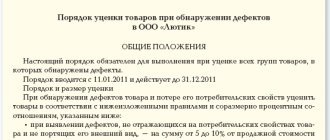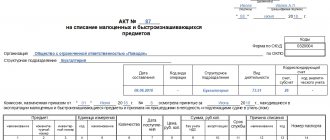Regulatory framework for the formation of reserves for impairment of inventories
The prerequisites for the formation of the reserve are laid down:
- in paragraph 25 of PBU 5/01, which requires disclosure in the reporting of information about the reduction in the book value of inventories through the formation of a reserve;
- in paragraph 20 of the guidelines for accounting of inventories (approved by order of the Ministry of Finance of the Russian Federation dated December 28, 2001 No. 119n), which describes the general procedure for creating a reserve;
- in the chart of accounts and instructions to it (by order of the Ministry of Finance of the Russian Federation dated October 31, 2000 No. 94n) regarding the allocation of an independent account 14 (“Reserves for reducing the cost of inventories”) for keeping records of such reserves.
From 2022, all economic entities are required to apply FAS 5/2019 “Inventories”, because PBU 5/01 will no longer be in force. You can start applying the standard earlier by fixing the new provisions in the accounting policies of the enterprise.
ConsultantPlus experts explained in detail what will change in the accounting of goods when applying FAS 5/2019. To do everything correctly, get trial access to the system and go to the Ready solution. It's free.
Reserve for reduction in the cost of inventories
All organizations (except for those who have the right to conduct simplified accounting) are required to create a reserve for the reduction in value (impairment) of material assets.
This is necessary when the possible sale price of inventories (raw materials, supplies, goods) has become less than their book value (clause 25 of PBU 5/01 “Accounting for inventories”, approved by order of the Ministry of Finance of Russia dated 06/09/01 No. 44n, p 20 Guidelines for accounting of inventories, approved by order of the Ministry of Finance of Russia dated December 28, 2001 No. 119n, hereinafter referred to as Guidelines). For example, when MPZs become obsolete or lose their original properties.
At the same time, it is necessary to check all inventories for impairment, including those reflected in the debit 10 “Materials”, 41 “Goods” and 43 “Finished Products”.
This must be done at least once a year - before preparing annual reports (clause 25 of PBU 5/01).
In what cases is a reserve not created?
A reserve for a decrease in the value of material assets is not created in the following cases:
- for raw materials, materials and other materials used in the production of finished products, works, provision of services, if as of the reporting date the current market value of these finished products, works, services corresponds to or exceeds its actual cost;
- for a reduction in the value of goods listed as goods shipped at the reporting date, if the sales price is not lower than the book value of the goods (see letters of the Ministry of Finance of Russia dated January 29, 2008 No. 07-05-06/18, dated January 29, 2009 No. 07-02-18 /01);
- if the organization has the right to use simplified methods of accounting, including simplified accounting (financial) reporting (clause 25 of PBU 5/01). In this case, the balances of inventories are reflected in the financial statements at the value determined in the accounting accounts - regardless of the obsolescence of these objects, their loss of original quality, changes in their current market value, or sale price. You can begin to apply this simplified method in relation to inventories from the financial statements for 2016 or from the statements for any subsequent year.
In other cases, a reserve must be created. It is created for each unit of inventories accepted in accounting, or for individual types (groups) of similar or related inventories, except for such enlarged groups (types) of inventories as auxiliary materials, finished products, goods, etc.
In a situation where an agreement has been concluded for the sale of goods (finished products) at a price below the book value of this property, and revenue has not yet been recognized, it is also necessary to create a reserve for the difference between the book value and the sale price of the property.
In this case, the fact of shipment of these inventories to the buyer does not matter (attachment to the letter of the Ministry of Finance of Russia dated January 29, 2014 No. 07-04-18/01).
Creating a reserve
The creation of a reserve for a decrease in the cost of raw materials is recognized as a change in the estimated value (clause 2 of PBU 21/2008 “Changes in estimated values”, approved by order of the Ministry of Finance of Russia dated October 6, 2008 No. 106n).
Changes in the estimated value are reflected in accounting prospectively (by inclusion in income or expenses) (clauses 3, 4 of PBU 21/2008).
The reserve is formed for the amount of the difference between the current market value and the actual cost of inventories (clause 25 of PBU 5/01, clause 20 of the Methodological Instructions).
Thus, when creating a reserve for reducing the cost of inventories, other expenses are recognized (clause 20 of the Methodological Instructions, clauses 11, 16 of PBU 10/99 “Organizational Expenses”, approved by order of the Ministry of Finance of Russia dated 06.05.99 No. 33n).
When restoring the reserve for a decrease in the value of inventories, the amount of the reserve accrued for a decrease in the value of inventories must be taken into account as part of other income (clause 20 of the Methodological Instructions).
The creation and restoration of a reserve for a decrease in the value of inventories is reflected in account 14 “Reserves for a decrease in the value of material assets” (Instructions for the application of the Chart of Accounts for accounting financial and economic activities of organizations, approved by order of the Ministry of Finance of Russia dated October 31, 2000 No. 94n).
The formation of a reserve for a decrease in the cost of inventories is reflected by the posting:
Debit 91 subaccount 91-2 Credit 14
A change in the amount of the reserve for a decrease in the cost of inventories occurs in the following cases.
Firstly, when the market value of inventories increases, for which a reserve was previously created to reduce the value of inventories. In such a situation, the amount of the reserve for reducing the cost of inventories is reduced in one of the following ways:
- by allocating part of the Reserve for the reduction in the value of inventories to the reduction in the cost of material expenses recognized in the period following the reporting period (paragraph 8 of clause 20 of the Methodological Instructions) or
- by inclusion in the organization’s other income (clause 2, 4 PBU 21/2008, Instructions for using the Chart of Accounts, clause 7, 16 PBU 9/99 “Income of the organization”, approved by order of the Ministry of Finance of Russia dated 05/06/99 No. 32n). This is reflected by the wiring:
Debit 14 Credit 91 subaccount 91-1
The organization chooses the method of adjusting the reserve to reduce the cost of inventories independently and enshrines it in its accounting policy (clause 7 of PBU 1/2008 “Accounting Policy of the Organization”, approved by order of the Ministry of Finance of Russia dated October 6, 2008 No. 106n).
However, it is more logical to include the decrease in the reserve in other income, since other expenses were reflected when it was created.
When determining the period for adjusting the reserve for a decrease in the cost of inventories, the organization has the right to be guided by the requirements of timeliness and diligence (paragraph 3, 4, paragraph 6 of PBU 1/2008).
Secondly, the release of inventories related to the reserve for reducing the cost of inventories. In this case, the reserve for reducing the value of inventories is written off in the only way - to increase financial results:
Debit 14 Credit 91 subaccount 91-1
The postings will be as follows.
Creating a reserve:
Debit 91-2 Credit 14
— a reserve has been created (additionally accrued) to reduce the cost of inventories.
As of the reserve restoration date:
REVERSE Debit 91-2 Credit 14 or Debit 14 - Credit 91-1
— the reserve for previously depreciated inventories was restored either upon their disposal or upon an increase in market value.
Confirmation of the current market value of inventories
The taxpayer independently estimates the current market value of the inventory and must provide confirmation of this calculation (clause 3 of PBU 21/2008 “Changes in estimated values”, approved by order of the Ministry of Finance of Russia dated October 6, 2008 No. 106n).
The organization must provide confirmation of the calculation of the current market value of inventories (clause 20 of the Guidelines).
The procedure for determining the current market value of inventories is not established by law.
Therefore, it is determined by the organization and enshrined in the accounting policy (clause 7 of PBU 1/2008 “Accounting policy of the organization,” approved by order of the Ministry of Finance of Russia dated October 6, 2008 No. 106n).
The calculation is made on the basis of information available before the date of signing the financial statements. The following are taken into account:
- appointment of MPP;
- current market value of finished products, in the production of which raw materials, supplies and other materials are used;
- changes in price or actual cost that are directly attributable to events after the reporting date.
Note that the determination of the current market value can be carried out in a manner similar to the procedure provided for assessing the market value of fixed assets (see clause 29 of the Guidelines for accounting of fixed assets, approved by order of the Ministry of Finance of Russia dated October 13, 2003 No. 91n) .
Reserve and corporate income tax
The possibility of forming a reserve for reducing the value of material assets for profit tax purposes is not provided for by Chapter 25 of the Tax Code of the Russian Federation.
Since tax accounting does not create a reserve for the depreciation of material assets, when creating this reserve, as well as its restoration in the tax accounting of the organization, neither income nor expenses arise.
Application of PBU 18/02
The difference between accounting and tax profit arising in connection with the creation of a reserve for the impairment of inventories (not recognized as an expense in tax accounting) can be considered as a deductible temporary difference (DTD), leading to the formation of a deferred tax asset (DTA) (clause 3, 8, 11, 14 PBU 18/02 “Accounting for calculations of corporate income tax”, approved by order of the Ministry of Finance of Russia dated November 19, 2002 No. 114n).
When the amount of the reserve is restored and the corresponding income (not recognized in tax accounting) is recognized in the accounting records, the specified IVR and ONA are repaid (clause 17 of PBU 18/02).
At the same time, there is a point of view according to which, since such an expense as deductions to the reserve for depreciation of goods and materials is not taken into account as an independent type of expense for profit tax purposes, it can be considered as a permanent difference (PD), leading to the formation of a permanent tax obligations.
With this approach, when restoring the reserve and recognizing income, the accounting records reflect the occurrence of the PR and the corresponding permanent tax asset (clauses 4, 7 of PBU 18/02).
Reserve and accounting reporting
In general, inventories that have partially lost their original qualities are reflected in the balance sheet at the end of the reporting year at the current market value, taking into account the physical condition of the inventories.
Thus, in the balance sheet, impaired inventories are reflected in line 1210 “Inventories” minus the reserve (clauses 25, 35 of PBU 4/99).
In the statement of financial results, contributions to the reserve are reflected in line 2350 “Other expenses”, and the restored amounts of the reserve are reflected in line 2340 “Other income”.
Example 1 The actual cost of raw materials in the organization’s accounting (equal to the price of its acquisition in tax accounting) is 400,000 rubles.
At the end of the reporting year, a partial loss of the properties of raw materials was revealed and it was established that the market price of products made from such raw materials will be less than the actual cost of these products.
The current market value of raw materials at the end of the reporting year was 200,000 rubles.
The following year, the raw materials were sold for 236,000 rubles. (including VAT RUB 36,000).
Prior to the sale, the amount of the reserve for reduction in the cost of raw materials was not adjusted.
Tax accounting uses the accrual method.
In the organization's accounting, the creation of a reserve for a decrease in the cost of raw materials due to the partial loss of their properties, as well as the subsequent sale of these raw materials, should be reflected as follows.
When creating a reserve:
Debit 91-2 Credit 14
— 200,000 rub. (400,000 - 200,000) - a reserve has been created to reduce the cost of raw materials (basis: accounting reference-calculation);
Debit 09 Credit 68/ONA
— 40,000 rub. (200,000 x 20%) - reflected by IT (basis: accounting certificate-calculation).
When selling raw materials:
Debit 62 Credit 91-1
— 236,000 rub. — other income from the sale of raw materials is recognized (base: invoice for the supply of materials to the outside);
Debit 91-2 Credit 10
— 300,000 rub. — the actual cost of raw materials is written off (basis: accounting certificate-calculation);
Debit 91-2 Credit 68-VAT
— 36,000 rub. — VAT has been charged (base: invoice);
Debit 14 Credit 91-1
— 200,000 rub. — the reserve for reducing the cost of raw materials was restored (basis: accounting certificate);
Debit 68/ONA Credit 09
— 40,000 rub. — SHE has been repaid (basis: accounting certificate).
Example 2 The actual cost of goods in the organization’s accounting is 800,000 rubles. The market value of this product at the end of the reporting year was 600,000 rubles. At the end of the first quarter of next year, the market price of the product dropped to 500,000 rubles. The organization's accounting policy establishes that adjustments to estimated values are made once a quarter.
In the organization's accounting, the creation of a reserve for a decrease in the cost of purchased goods due to a decrease in its current market value, as well as the subsequent adjustment of the amount of this reserve due to a further decrease in the market value of the goods should be reflected as follows.
When creating a reserve:
Debit 91-2 Credit 14
— 200,000 rub. (800,000 - 600,000) - a reserve has been created to reduce the cost of goods
(basis: accounting certificate-calculation);
Debit 09 Credit 68/ONA
- 40,000 (200,000 x 20%) - reflected by IT (basis: accounting certificate-calculation).
When increasing the reserve:
Debit 91-2 Credit 14
— 100,000 (600,000 — 500,000) — the amount of reserve for reduction in the value of goods has been increased
(basis: accounting certificate-calculation);
Debit 09 Credit 68/ONA
- 20,000 (100,000 x 20%) - reflected by IT (basis: accounting certificate-calculation).
Audit Department of RIGHT WAYS LLC
Under what conditions should a reserve be formed?
In accordance with the above standards, the criteria for creating a reserve are as follows:
- The inventories available to the enterprise show signs of decreasing value:
- obsolete (no longer used in the production of manufactured products);
- have lost their original properties completely or partially;
- market prices for similar MPZs decreased.
- Inventory inventories do not belong to the separate consolidated groups of inventory accounting, named in clause 20 of the guidelines of the Ministry of Finance of the Russian Federation, namely:
- are not a group of basic production materials;
- are not a group of auxiliary materials for main production;
- do not relate to finished products or goods;
- do not relate to the reserves of a specific segment (geographical or operational).
- The amount of the reserve can be estimated with a sufficient degree of reliability. The basis for forming an expert opinion on the estimated value of the reserve can be:
- internal official documents (office memos, acts confirming, for example, the loss of useful properties of MPZ located in the warehouse);
- external information (for example, price lists of other sellers, confirming the fact of a decrease in prices on the market for one or another type of materials);
- enterprise accounting registers (for example, data from accounts with suppliers, confirming a stable decrease in the purchase price of inventories).
If the inventory in question has most of the characteristics listed above, then a reserve must be created for it for the difference between the actual cost of acquisition (capitalization) and the real market price of this inventory as of the reporting date.
The need to create a reserve
The need to create a reserve for reducing the value of material assets is dictated by the requirements of accounting standards. Thus, clause 25 of the Accounting Regulations “Accounting for inventories”, approved. Order of the Ministry of Finance of the Russian Federation dated 06/09/2001 No. 44n (hereinafter referred to as PBU 5/01) established that inventories that are obsolete, have completely or partially lost their original quality or current market value, the sale price of which has decreased, are reflected in the balance sheet at the end of the reporting year minus the reserve for a decrease in the value of material assets.
In addition, in paragraph 62 of the Regulations on accounting and financial reporting in the Russian Federation, approved. Order of the Ministry of Finance of the Russian Federation dated July 29, 1998 No. 34n states that finished products, goods, raw materials, basic and auxiliary materials, fuel, purchased semi-finished products and components, spare parts, containers used for packaging and transporting products (goods), and other material resources for which the price has decreased during the reporting year or which have become obsolete or partially lost their original quality are reflected in the balance sheet at the end of the reporting year at the price of possible sale, if it is lower than the initial cost of procurement (purchase), with the difference being allocated to prices on financial results.
In recommendations to audit organizations for conducting an audit of the annual financial statements of organizations, representatives of the financial department, considering the verification of the correctness of the assessment of finished products in the balance sheet at the end of the year, focused attention on the need to analyze concluded contracts with consumers (letter of the Ministry of Finance of the Russian Federation dated January 29, 2014 No. 07-04 -18/01). If the price of finished products is lower than its cost, the organization must create a reserve for its depreciation.
RESTORATION OF ACCOUNTING AND TAX ACCOUNTING
Thus, three situations can be identified in which the creation of a reserve is mandatory:
- material assets have become obsolete, have completely or partially lost their original quality;
Technical specialists of the organization (for example, technologists) can identify morally and physically obsolete material assets that cannot participate in the production process. As a rule, organizations have created a permanent working commission, which determines the list of such materials. Based on the conclusion (act) of the commission, a protocol is created on the further use (or non-use) of such material assets.
In modern ERP systems (for example, SAP R/3) special reports are generated on unused balances of material assets for more than 12 months in the context of homogeneous groups. The mere fact of non-use of material assets without a specific analysis for a long time cannot indicate the potential illiquidity of the latter. However, long-term non-use of materials can cause a decrease in the original qualities, and therefore there is a high probability of loss of value.
- the current market value of material assets has decreased;
Accounting standards do not define the methodology for establishing current market prices. As a rule, organizations use information about the price of the last purchase of materials from suppliers, data from commodity exchanges, and statistical information.
The source of information about the current market value of material assets can be provided in the accounting policy for accounting purposes or approved by a special order for the organization.
- the selling price of material assets has decreased.
Confirmation of information about a decrease in the sales value of material assets can be concluded in contracts with buyers in which the sales price of material assets is lower than cost.
ACCOUNTING SERVICES
Important!
A reserve is not created for material assets used in the production of finished products (performance of work, provision of services) if, as of the reporting date, the current market value of the finished product (work, services) corresponds to or exceeds their actual cost.
It should be noted that the need to create a reserve for reducing the cost of material assets is borrowed from international standards.
Paragraph 9.2 “Valuation of inventories” (IAS 2 Inventories) establishes that the assessment of material assets is reflected on the balance sheet date at the lower of two estimates:
- at cost (Cost model) or
- at net selling price (Net realisable value).
RESERVE FOR PAYMENT OF HOLIDAYS
How to determine the cost of inventories on the market?
First of all, it should be noted that the creation of a reserve is carried out for each unit of the inventory range or, subject to the conditions of typicality and homogeneity of the inventory items in question, for a local group.
The current value of inventories on the market should be understood as the actual amount of money that an enterprise can earn for its inventories if it puts them up for sale at the time of valuation. In addition to the information given above as a basis for analysis regarding reservations for inventories, the following can be used:
- official statistical data (for example, published by Rosgosstat);
- data presented in specialized media (for example, stock market data);
- applicable methods of analytical calculations (for example, unsatisfactory results of the analysis of the turnover of the inventories under consideration);
- expert assessments (for example, a report from an independent appraiser).
The method(s) chosen by the enterprise for determining market value for the formation of reserves must be fixed in the accounting policy for accounting purposes.
For more information about including data in the accounting policy, read: “Drafting a statement on the accounting policy in the organization.”
IMPORTANT! Since the entire procedure for revising the cost of inventories is carried out primarily so that the user of the enterprise’s reporting receives correct information about the state of affairs, when choosing assessment methods, priority should be given to those that are most suitable for the principle of prudence. That is, based on the results of the assessment, the enterprise should be more ready to recognize expenses (form a reserve) than to recognize assets (not to reflect information about inventory write-downs in the report). Thus, assessment information obtained from independent parties is preferable to data from experts directly associated with the enterprise.
Reflection of the reserve for depreciation of material assets in accounting
The reservation (reduction in the price of inventories) is reflected in the accounting of the commercial structure at the end of the reporting year. For these purposes, accounting position 14 “ Reservations for a decrease in the price of material assets ” is intended and used, where general information regarding the part of the formed reserve is recorded. Accounting for this position is carried out in relation to each reserve. Account 14 corresponds to:
- Credit - from account 91 “Other profits and expenses.” (Creation of a reserve for a decrease in value).
- Debit - from the account. 91 “Other profits and expenses.” (Renewal of the reserve amount as material assets are written off).
Thus, the following transactions are recorded in accounting:
| Debit | Credit | Characteristic |
| 91 “Other profits and expenses.” | 14 “Reservation for a decrease in value” | Formation of a reserve (before creating the annual balance sheet) |
| 14 “Reservation for price reduction” | 91 “Other profits and expenses.” | Renewal of the reserve amount (at the beginning of the period following the reservation) |
The balance in accounting position 14 shows the difference between the actual cost and the current market value at the end of the reporting year. Closing this accounting position assumes that the balances are completely used up in the new reporting period.
Example #1. Calculation of the reserve for a decrease in the price of material assets in a commercial structure and restoration of the reserve amount
By the end of 2015, Mirta LLC had 50 displays on its balance sheet. The actual cost of one such device is 1800 rubles, respectively, all 50 displays are 90 thousand rubles. (1800 * 50 = 90000).
The decrease in market prices at the end of the year amounted to 1 thousand rubles. per unit of goods. For this reason, the accounting department creates a reserve for price reduction before preparing the annual balance sheet.
The reserve amount is calculated as follows: the cost of a unit of goods - the amount of reduction in the market price * the total number of goods. The result is: (1800 –1000) * 50 units = 40 thousand rubles. This is the reserve amount.
The reserve amount for restoration is reflected as follows: DT 62, CT 90 - profit received from the sale of goods; DT 90, CT 68, subaccount “VAT” - VAT is withheld from the proceeds; DT 90, KT 41 - release (write-off) of the cost of sold displays; DT 14, CT 91, subaccount “Other profit” - release of the formed reserve.
Example #2. Reflection of reservation operations for reducing the price of material assets in the accounting of a commercial structure
At the end of 2015, an accountant at Mirta LLC due to a drop in the market price of goods listed on the balance sheet from 1,800 rubles. up to 800 rub. per unit, a reserve was created for a decrease in its value. The reserve amount (damage) amounted to 40 thousand rubles.
The resulting loss amounted to 40 thousand rubles. due to a decrease in the market value of the goods, it is included in the category of operating expenses. At the beginning of the next year 2016, the specified amount is renewed. Reservation transactions are reflected in the corresponding entries.
| Debit | Credit | Characteristic |
| 91 (Other income and expenses) | 14 (Reservation for reduction in price) | A reserve has been created for a decrease in value (40 thousand rubles) |
| 14 (Reservation for reduction in price) | 91 (Other income and expenses) | Release of the amount of the formed reserve for a decrease in value (40 thousand rubles) |
How is the reserve created and adjusted?
When the estimated value of the market value of existing inventories is determined, it is necessary to compare it with the current value of the same inventories at which they are listed in the accounting records as of the reporting date. If the estimated value is less than the current accounting (balance sheet) value, a reserve for the difference should be created.
At the same time, the balances of inventories themselves will be reflected in the reporting at their cost according to accounting. But the final value of the inventory section will be reduced by the amount of the reserve created under the credit of account 14 “Provisions for impairment of inventories.” By debit, reserves for reducing the value of material assets are recorded in other expenses of the enterprise.
Dt 91 Kt 14 - standard entry for creating a reserve for impairment of inventories.
Check whether you are correctly displaying the reserve for reducing the cost of goods using the Ready-made solution from ConsultantPlus. If you do not have access to the K+ system, get a trial online access for free.
Since the market value is an unstable value, and the value taken to form the reserve is estimated at a certain moment, both may change over time. This implies the need to periodically repeat the procedure for calculating the reserve and, if necessary, make adjustments to accounting and reporting.
IMPORTANT! The frequency of formation of the reserve under consideration is not established in accounting standards, therefore it should be determined and fixed in the accounting policy.
If changes have occurred on the date of re-analysis, the value of the reserve is either increased (by the same transaction with which the reserve was created) or decreased (restored). When restoring, the wiring is reversed: Dt 14 Kt 91.
IMPORTANT! The Tax Code of the Russian Federation does not consider the possibility of accounting for reserves for reducing the value of material assets in income tax expenses. Therefore, when creating a reserve, a deferred tax asset arises in the amount of: IT = Reserve amount × Tax rate, reflected by posting Dt 09 Kt 68/Income Tax.
For more information about deferred taxes, see: “What is deferred income tax and how to account for it?”
If there is sufficient confidence that the inventories for which a reserve was accrued at the end of the last reporting period will be fully used during the current period (for example, written off to production at actual cost), the created reserve can be restored at the beginning of the current period. Thus, the formation of this reserve will be relevant only as of the reporting date and will fulfill its function: it will show the reporting user the difference between the value of the enterprise’s inventory at the market and at the cost of capitalization. Similar recommendations are present in some industry guidelines, for example in the recommendations of the Ministry of Agriculture of the Russian Federation by order No. 654 of June 13, 2001 for enterprises of the agro-industrial complex.
Examples of accounting entries
To begin with, it is necessary to emphasize that the 14th count is active-passive in nature. The created funds are reflected in the credit part of the account, and the restored amount of the reserve or the amount by which the market price exceeds the actual one should be indicated in the debit of the account.
As for analytical accounting, it is maintained for each created fund separately.
Typical accounting entries for the designated position of the Chart of Accounts are as follows:
Creation of a fund, which at the end of the reporting period is formed for each type of inventory by reducing financial results:
Dt 91/2
Kt 14.
Reduction in fund volume as a result of disposal of inventories or increase in their market value:
Dt 14
Kt 91/1.
Results
Accounting for reserves for impairment of inventories is carried out in accordance with the standards outlined in regulatory legal acts in the field of accounting. At the same time, many aspects of the procedure for creating and accounting for such reserves are not clearly regulated by the current provisions. Therefore, the enterprise should formulate the applicable nuances of the formation of reserves and consolidate them in the accounting policy.
Find out about the disclosure of data on inventories in IFRS here: “IFRS No. 2 Inventories - features of application and purposes.”
You can find more complete information on the topic in ConsultantPlus. Free trial access to the system for 2 days.
Example of creating a reserve fund
Let’s imagine that at the end of 2022, a certain Invest LLC has 37,000 bricks on its balance sheet, the actual cost of which is 9.0 rubles per piece. Thus, the total cost was 333,000 rubles. During the year, the market price fell slightly and, in accordance with the results of trading on the commodity and raw materials exchange, at the end of the reporting period it amounted to 7.0 rubles. As a result, the total market price was 259,000 rubles. At the beginning of 2022, the company sold 15,000 units. bricks
Thus, due to disposal, part of the created reserve must be written off: 74,000: 37,000 * 15,000 = 30,000 rubles.
Accounting entries for account 14 as a result of a decrease in the market value of inventory items will look like this:
- Dt 91.02 - Kt 14 - 74,000 rubles, a fund has been formed to cover losses resulting from a decrease in value;
- Dt 14 - Kt 91.01 - 30,000 rubles, write-off of part of the reserve fund.










